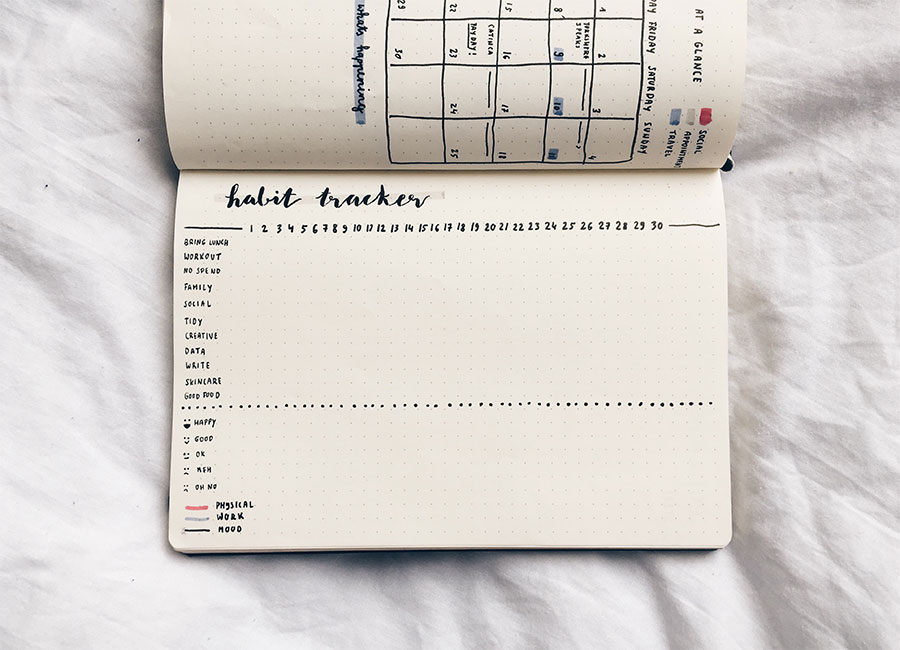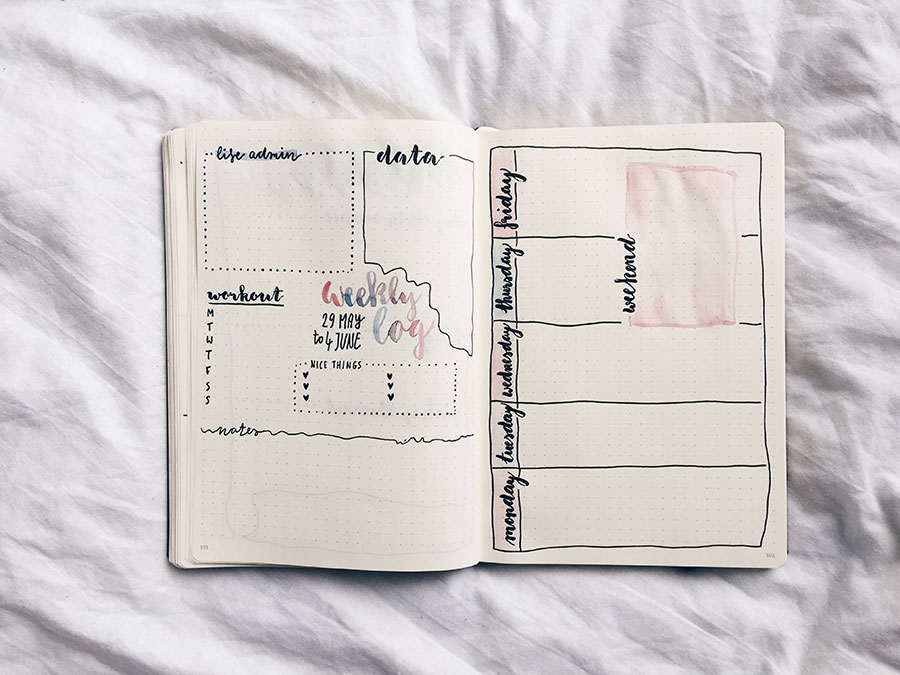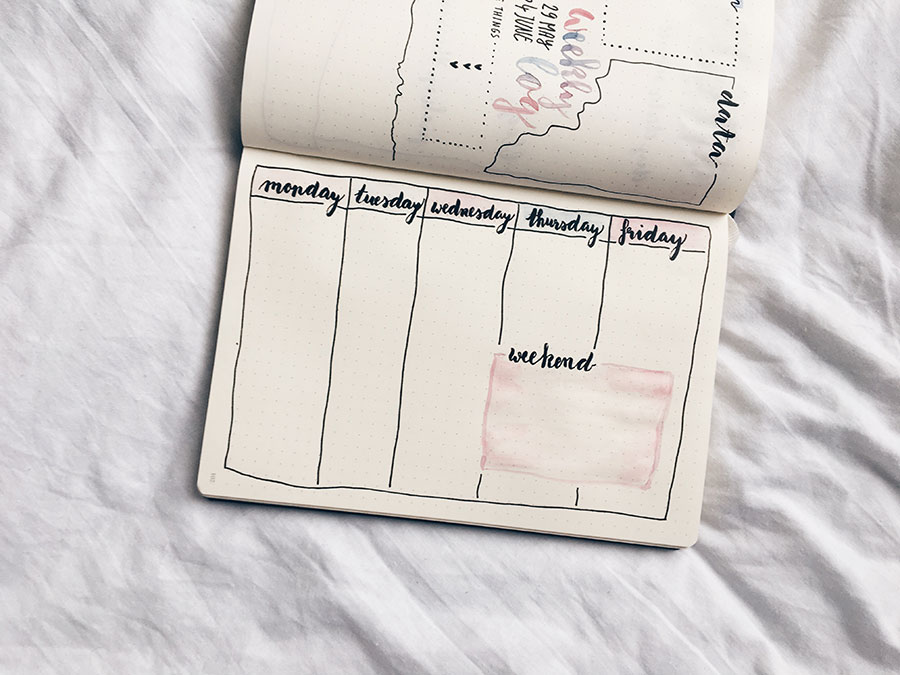I started bullet journaling pretty much exactly a year ago. In fact, I posted an Instagram snap of my very first custom page – a thesis tracker – with the caption ‘Let the bullet journaling begin’ on 1 June 2016. Spoiler alert – that particular bullet journal page never proved very useful (too little space) and was quickly abandoned. But since then, I’ve been writing into my journal more or less regularly, graduating from my trusted A5 moleskine notebook to the classic Leuchtturm model.
A way to bring structure into your life
Originally, I was desperately looking for a way to structure the last few months of my student life and avoid any last minute hand-in panics. Several hand-in panics later, I ended up falling in love with the system nevertheless. It’s functional, but it can be as pretty as you want it to be. It’s very visual – I’ve always found that writing down my thoughts and tasks helps me feel a little more in control of my to-do list. It’s super customisable – you can work with as many different spreads as you want, and figure out whatever is most useful to you and what doesn’t work at all. I tried to track the way I spend my time every day, for example, and realised very quickly (after five days or so) that there’s no point because my schedule doesn’t vary much; I work from 9 to 5 every day, and tend to spend most of my evenings at home during the week. But at the same time, I can create pages for whatever is going on in my life at the time. I can write pro and contra lists, collect ideas for things I want to write, and track my habits without feeling like I’m cluttering my daily planner or burying important pages in a completely unstructured notebook.
If you’ve managed to escape the Internet #bujo hype so far but are curious to learn a little more, have a look at this page – an introduction by the creator of the journal. Stripped down to the bare minimum, the bullet journal is simply a way to keep track of tasks and events and jot down notes. While many bullet journals are absolutely stunning and the journal has become a bit of an art form in itself, aesthetics isn’t really what it’s all about. If you’re not a fan of hand lettering, watercolour and calligraphy, you can still reap all the benefits of this system. What I love about the bullet journal the most is that it’s perfect to calm noisy minds. You don’t need expensive text markers to empty your brain onto the page.
My monthly set up
That said, I unashamedly love the artsy aspect of bullet journaling. I love arts and crafts, but I often struggle to find space for it in my daily life, so having the bullet journal as part of my weekly routine on Sundays allows me to get creative while doing something useful for the week ahead. This weekend, I spent slightly more time than usual setting myself up for June and I thought I’d share what my journal looks like before things get messy.
I love my monthly overview. Many people don’t tend to find this kind of calendar-view very useful, but I love that I can see my entire upcoming month at a glance. Let’s put it that way – if I forget to make note of an event or appointment in here, there’s a 50 percent chance I will forget about it until the night before or double-book myself. I also like writing down a few goals for the months and take a note of what else is going on.
My habit tracker has endured several drastic make-overs, but I’ve now settled on this cute minimalist version that also includes a mood tracker at the bottom. I often feel stress in my body slightly delayed, so I would love to use this to check if there’s a pattern to how I feel and to what extent my (healthy) habits have an effect on my mood.
Tracking my expenses is something I need to get better at, so I include an expense tracker in my monthly spread to make it easier for me to figure out where I’m spending too much and what my weaknesses are (usually tasty food). On the right, I’ve created a pretty page to collect ideas for my side projects, like listing blog posts I want to write and what I’m planning to cover for my DIY Data Science series. It’s pretty informal, but I like having a dedicated space for these things beyond a small box in my weekly spread.
Here’s my weekly log – I change it up all the time, but I always include some space for life admin that needs to get done, since recently a box for my data project, a little gratitude log, and my workout tracker.
My week at a glance is a zoomed-in version of my month at a glance, with more space to keep track of daily tasks and events. This is also where I use the classic bullet journal system the most – I use boxes and empty dots for tasks and events respectively and colour them in once I’m done.
These are the few staples you can always find in my bullet journal, and because I do them regularly, they’re also the nicest looking pages. I have plenty of messy brainstorming pages or notes from talks that I now struggle to decipher. I used to be quite precious about my bullet journal and wanted it all to look pristine, but I realised that if you’re too careful you fail to take full advantage of the system. Sometimes you need a beautifully designed weekly spread, but sometimes you just need to put something – anything – down on paper, and that’s okay too.
If you want to get started with bullet journaling but don’t quite know how to go about it, please do get in touch, I’m always happy to help. And if you’re looking for more inspiration, my lovely friend Jasmin is a bullet journal pro and regularly posts videos of her bullet journal month where you can see the system in action.





